 W
WThe American Bobtail is an uncommon breed of domestic cat which was developed in the late 1960s. It is most notable for its stubby "bobbed" tail about one-third to one-half the length of a normal cat's tail. This is the result of a cat body type genetic mutation affecting the tail development, similar to that of a Manx cat. The breed is not related to the Japanese Bobtail despite the similar name and physical type—the breeding programs are entirely unrelated, and the genetic mutation causing the bobbed tail are known to be different because the mutation causing the American Bobtail's tail is dominant, whereas the Japanese Bobtail tail mutation is recessive.
 W
WThe American Curl is a breed of cat characterized by its unusual ears, which curl back from the face toward the center of the back of the skull. An American Curl's ears should be handled carefully because rough handling may damage the cartilage in the ear. The breed originated in Lakewood, California, as the result of a spontaneous mutation.
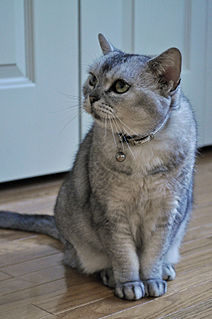 W
WThe American Shorthair (ASH) is a breed of domestic cat believed to be descended from European cats brought to North America by early settlers to protect valuable cargo from mice and rats. According to the Cat Fanciers' Association, in 2012, it was the seventh most popular pedigreed cat in the United States.
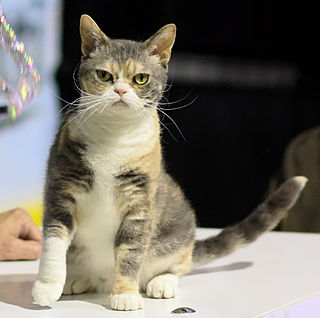 W
WThe American Wirehair is a breed of domestic cat originating in upstate New York. As of 2017, though the breed is well-known, it is ranked as the most rare of the 41 Cat Fanciers' Association breeds.
 W
WThe Balinese is a long-haired breed of domestic cat with Siamese-style point coloration and sapphire-blue eyes. The Balinese is also known as the purebred long-haired Siamese, since it originated as a natural mutation of that breed and hence is essentially the same cat with a medium-length silky coat and a distinctively plumed tail.
 W
WThe Bengal cat is a domesticated cat breed created from hybrids of domestic cats, especially the spotted Egyptian Mau, with the Asian leopard cat. The breed name comes from the leopard cat's taxonomic name.
 W
WThe Bombay cat is a type of short-haired cat developed by breeding sable Burmese and black American Shorthair cats, to produce a cat of mostly Burmese type, but with a sleek, panther-like black coat. Bombay is the name given to black cats of the Asian group. The Bombay cat is also called the Black Mamba, and nicknamed the "mini-panther".
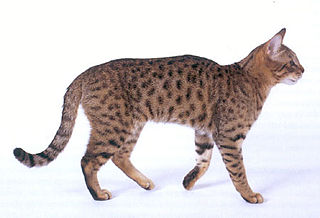 W
WThe California Spangled is a breed of domestic cat that was bred to resemble spotted wild cats, like the ocelot and leopard. They were originally bred in the 1980s and were only ever a rare breed, with only 58 ever being registered. They were usually expensive, priced between US$800 and $2,500. The popularity of two other spotted cats breeds, the Ocicat and the Bengal, overshadowed their development.
 W
WThe Chantilly-Tiffany or Chantilly/Tiffany, also known as the Chantilly or the Foreign Longhair, is a breed of domestic cat which originated in North America. The Chantilly Tiffany was once thought to be extinct, but it is around and thriving.
 W
WA felid hybrid is any of a number of hybrid between various species of the cat family, Felidae. This article deals with hybrids between the species of the subfamily Felinae.
 W
WColorpoint Shorthairs are a variety of domestic cat. Depending on the cat registry, they may be considered a separate breed of cat, or more often a variant of a pre-existing one, if accepted at all. These cats are distinguished by their conformance to wide range of sixteen different point colors, beyond the four standard Siamese colors. The variety was initially created by crossbreeding Siamese with the American Shorthair – the same mixture that created the Oriental Shorthair, but with different goals. The Colorpoint Shorthair shares the point-coloration pattern with the Siamese, but in the nontraditional colors of red, cream, tortoiseshell, and lynx (tabby) points, and minor variations thereof. In body style, head shape, and other features, it may be intermediate between the two foundation breeds, which show cats leaning toward Siamese traits. Those who favour the Traditional Siamese look may also favour the more moderate-typed Colorpoint Shorthairs that take after their American Shorthair ancestors in shape.
 W
WThe Exotic Shorthair is a breed of cat developed as a short-haired version of the Persian. The Exotic is similar to the Persian in many ways, including temperament and conformation, a flat nose and face with the exceptions of the short dense coat.
 W
WThe Highlander, is an experimental breed of cat. The unique appearance of the Highlander comes from the deliberate cross between the Desert Lynx and the Jungle Curl breeds, also recently developed. The latter of these has some non-domestic ancestry from two Asian small cat species, the leopard cat and jungle cat, making the Highlander nominally a feline hybrid, though its foundation stock is mostly domestic cat.
 W
WThe Himalayan, is a breed or sub-breed of long-haired cat similar in type to the Persian, with the exception of its blue eyes and its point colouration, which were derived from crossing the Persian with the Siamese. Some registries may classify the Himalayan as a long-haired sub-breed of Siamese, or a colorpoint sub-breed of Persian. The World Cat Federation has merged them with the Colorpoint Shorthair and Javanese into a single breed, the Colorpoint.
 W
WThe Javanese, also known as the Colorpoint Longhair in some registries, is a variety of purebred domestic cat. It is an Oriental-type, the long-haired equivalent of the Colorpoint Shorthair. The variety was developed in North America; its name is derived from the tradition of naming Oriental-type cats after Southeast Asian places. It is an offshoot of the Balinese breed, out-crossed to Siamese and Colorpoint Shorthair, and often having coat patterns not acceptable in those breeds. Individuals may or may not be have point coloration.
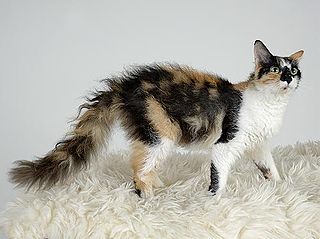 W
WThe LaPerm is a breed of cat. A LaPerm's fur is curly, with the tightest curls being on the belly, throat, and base of the ears. LaPerms come in many colors and patterns. LaPerms generally have a very affectionate personality.
 W
WThe Lykoi is a natural mutation from a domestic shorthair that looks like the popular idea of a werewolf. The mutation has occurred in domestic cats over the last 20 years. DNA testing has been done by UC Davis to confirm that the cats do not carry the Sphynx/Devon Rex gene. The breed was developed in Vonore, Tennessee. "Lykoi" means 'wolves' in Greek.
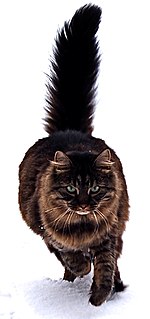 W
WThe Maine Coon is the largest domesticated cat breed. It has a distinctive physical appearance and valuable hunting skills. It is one of the oldest natural breeds in North America, specifically native to the US state of Maine, where it is the official state cat.
 W
WThe Minskin is a breed of cat derived from intentional hybrid cross-breedings between the Munchkin and Burmese with the addition of Sphynx and Devon Rex which all lent to their development. It is a low-riding, rug-hugger breed with short legs and fur-pointed coat. They are described as having a small to medium-sized semi-cobby muscular body, a rounded head, large ears that are wide at the base, a short broad muzzle with prominent whisker pads and eyes that are large and round, spaced well apart, giving them an open alert expression. Their fur is a sparse rex-coat, which is more dense on their outer extremities, giving them a unique coat description of "fur-points" that defines the mask, ears, legs and tail, with a more sparsely coated cashmere-like torso. Minskin cats are often described as exotic and alien-like, they are sweet tempered and affectionate cats that are playful but not destructive. They are a healthy, small breed that require little grooming and get along with other animals, thrive on human interaction and are particularly fond of children.
 W
WThe Munchkin cat or Sausage cat is a newer breed of cat characterized by its very short legs, which are caused by a genetic mutation. The Munchkin is considered to be the original breed of dwarf cat.
 W
WThe Ocicat is an all-domestic breed of cat which resembles a wild cat but has no wild DNA in its gene pool. The breed is unusual in that it is spotted like a wild cat but has the temperament of a domestic animal. It is named for its resemblance to the ocelot. The breed was established from the Siamese and Abyssinian. American Shorthair was also added to the original crosses due to an error in the Cat Fanciers' Association, Inc's recording of the breeds used. This mix of breeds created a healthy, large breed of cat completely different in type and appearance from the source breeds.
 W
WOjos Azules is a breed of domestic cat.
 W
WAn Oriental bicolour is any cat of Oriental type, either long-haired or short-haired and in any pattern including colourpoint, which has white areas on its coat caused by the white spotting gene. In most cat fancier and breeder organisations, Oriental bicolours do not constitute a standardised breed, but a coat pattern variant of the breed of their foundation stock. One breed registry is an exception, the UK-based Governing Council of the Cat Fancy (GCCF), which has defined them as a separate breed named Oriental Bicolour (capitalised).
 W
WThe Oriental Shorthair is a breed of domestic cat that is developed from and closely related to the Siamese cat. It maintains the modern Siamese head and body type but appears in a wide range of coat colors and patterns. Like the Siamese, Orientals have almond-shaped eyes, a triangular head shape, large ears, and an elongated, slender, and muscular body. Their personalities are also very similar. Orientals are social, intelligent, and many are rather vocal. They often remain playful into adulthood, with many enjoying playing fetch. Despite their slender appearance, they are athletic and can leap into high places. They prefer to live in pairs or groups and also seek human interaction. Unlike the breed's blue-eyed forebear, Orientals are usually green-eyed. The Oriental Longhair differs only with respect to coat length.
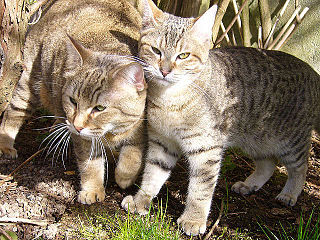 W
WThe Pixie-bob is a breed of domestic cat claimed to be the progeny of naturally occurring bobcat hybrids. However, DNA testing has failed to detect bobcat marker genes, and Pixie-bobs are considered wholly domestic for the purposes of ownership, cat fancy registration, and import and export.
 W
WThe Ragamuffin is a breed of domestic cat. It was once considered to be a variant of the Ragdoll cat but was established as a separate breed in 1994. Ragamuffins are notable for their friendly personalities and thick, rabbitlike fur. Much like the ragdoll, they are also one of the laziest breeds, because of this they should be kept as indoor pets.
 W
WThe Ragdoll is a cat breed with a color point coat and blue eyes. They are large and muscular semi-longhair cats with a soft and silky coat. Developed by American breeder Ann Baker in the 1960s, they are best known for their docile and placid temperament and affectionate nature. The name "Ragdoll" is derived from the tendency of individuals from the original breeding stock to go limp and relaxed when picked up.
 W
WThe Savannah is a hybrid cat breed. It is a cross between a serval and a domestic cat.
 W
WThe Selkirk Rex is a breed of cat with highly curled hair.
 W
WThe Serengeti is a breed of domestic cat, first developed by crossing a Bengal and an Oriental Shorthair. Recognized and registered by The International Cat Association (TICA), no other first generation crosses can be registered as Serengeti. From the Bengal × Oriental cross came the first foundation Serengeti. Breeders then worked with the cat to produce a cat that resembles the breed profile set by TICA. Created by biologist Karen Sausman of Kingsmark Cattery in California in 1994, the breed is still in the development stages, but the ultimate aim is to produce a cat that looks similar to a serval, without using any recent wild cat blood. Serengetis are spotted cats, with long legs and very large, round tipped ears. They have a long neck which blends with the base of the skull without tapering. Males are generally slightly larger and heavier than females and can weigh between 10 and 15 lbs; females generally weigh between 8 and 12 lbs. They are recognized by TICA in tabby, ebony silver, ebony smoke and solid black. A group of breeders in the UK are currently working towards getting TICA to also recognise the snow spotted variety.
 W
WSingapura adult females cat reach sizes up to 4 pounds. Adult males cat be up to 8 pounds. What they lack in size, they make up in personality. They are great pets.
 W
WThe Snowshoe is a breed of cat originating in the United States of America in the 1960s. Snowshoes were first produced in Philadelphia when a Siamese breeder's cat gave birth to three kittens with white feet. The breeder, Dorothy Hinds-Daugherty, then began a breeding program to produce what were originally called "Silver Laces", crossing the strangely marked Siamese cats with bi-color American Shorthair cats and other breeds. When Hinds-Daugherty left the program, Vikki Olander began working with the cats and recruited new breeders, as well as worked towards full recognition within cat associations. Despite having existed for 45 years, Snowshoes are rare due to the difficulty of reproducing the correct coat markings. The marks are based on recessive genes for color points and on the co-dominant but variably-expressed piebald pattern gene, making it difficult to predict the appearance of offspring.
 W
WThe toyger is a breed of domestic cat, the result of breeding domestic shorthaired tabbies to make them resemble a "toy tiger", as its striped coat is reminiscent of the tiger's. The breed's creator, Judy Sugden, has stated that the breed was developed in order to inspire people to care about the conservation of tigers in the wild. It was recognized for "registration only" by The International Cat Association in the early 1990s, and advanced through all requirements to be accepted as a full championship breed in 2007. There are about 20 breeders in the United States and another 15 or so in the rest of the world, as of 2012.
 W
WThe York Chocolate was an uncommon American breed of show cat, with a long, fluffy coat and a tapered tail and most of them were mostly or entirely chocolate-brown or the dilute form of brown, known as lavender. The breed was named after New York state, where it was established in 1983. This breed was created by color-selecting domestic long-haired cats of mixed ancestry. The breed was not widely recognized by cat registries. It was not recognized by the major organizations such as The International Cat Association (TICA), the Cat Fanciers' Association or Fédération Internationale Féline. By 2015 there was only one listed breeder of York Chocolates. By 2016 no registry carried its breed standard, there were no breeder websites and the breed is considered extinct. Although similar looking random-bred cats can be found today, without pedigree papers these are not York Chocolate cats.